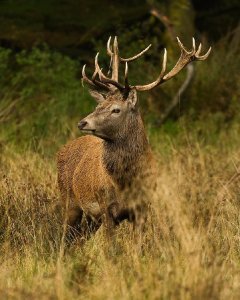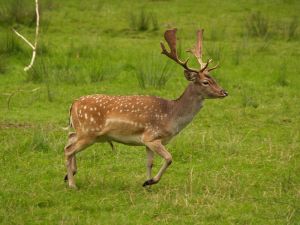Once upon a time, if you had a country house, you had to have deer too. At Studley Royal, part of the Fountains Abbey and Studley Royal World Heritage Site, there are deer and a deer park….. but no country house.
There was a medieval manor house once. That burnt down in 1716. John Aislabie, who inherited the site, and was responsible for the magnificent water gardens here, rebuilt the site as a Palladian mansion. That burnt down too, in 1946. There is no house any more. But there are some 350 deer.
And on Saturday afternoon, we went to see them, and to find out more. We’d been promised a grey but tolerable day. In fact, it was grey and intolerable, with drizzle turning to driving rain. But if the deer – some 350 of them – could manage, so could we.
Some of them are red deer, the native species of the British Isles, and the largest.

Some are fallow deer. These were introduced to Britain by the Normans, and became prized as ornamental animals, and for hunting. They’re smaller than red deer, and perhaps seen as prettier. They can come in two shades of tan with spotted coats, or in some cases black, or even white. Look at their antlers: quite different from those of the red deer.

And some are sika. They look a little like darker versions of fallow deer (not the antlers though), and were introduced from China and Japan in the 19th century.

We learnt to distinguish one from the other by looking at their size, their antlers, their coats, their markings, their tails. We learnt that deer are responsible for the very neat way in which the trees in the park are finished off. Deer graze the leaves they can reach, thus leaving all the lowest branches and twigs at exactly the same height. They’ll all happily munch bramble, gorse and nettles too: stinging leaves and prickly thorns don’t worry them at all.
At this time of year the males are losing their antlers. They lose and re-grow them every year, which is a terrific drain on their energy, so they tend to take things fairly easy while this is happening in the early summer. Each year until they’re aged 10 or so, they’ll grow larger antlers than the year before, and with more points. New antlers are velvety, so stags will spend time rubbing this soft coating off by scraping their new accessories against the dead wood that’s deliberately left lying in the deer park. They’ll want them to be good and ready for the rutting season when they’ll wrestle other males in the quest to be the females’ Top Stag.
They’ll also enjoy a wallow. We saw muddy depressions here and there where deer have lain down to have a good old scratch and bathe in thick oozy mud. At this time of year it’s to help free themselves of their winter coat as they moult. But it’s a different story in the breeding season. Males urinate into the earth to make it even muddier. Then they’ll roll round in the resulting muddy soup. Their splendid appearance and smell as they rise up, magnificently coated in sticky earth and bits of vegetation makes them thoroughly alluring to the females they hope to attract.
On Saturday, the deer were edgy, a little spooked. Nobody knew why. The large groups we saw were always at a distance, always ready to bolt away. The three varieties of deer don’t really mix, but neither do they feel the need to place real distance between themselves. We didn’t get to see them at close quarters. But we saw them well enough to distinguish one species from another with increasing confidence. A good day then, despite the increasingly dirty weather. We’ll be back when the sun shines, to visit the deer again.
Thanks to members of the volunteer Wildlife Team at Fountains Abbey and Studley Royal for our afternoon with the deer.






How neat! You managed some good photos, in spite of the weather and the distance–aren’t they all gorgeous? And all different, I think, from the white-tail deer we have here.
LikeLike
Some of these have rather white tails too. But I dunno. I have a long way to go before I can call myself an expert. ‘Gorgeous’ covers it for all of them, I think.
LikeLike
what an interesting and informative piece. And excellent photos, proving that rain and cloud merely serve to enhance the deers’ attractiveness, for humans anyway. Other things may work for the female of the deer species…
LikeLike
Hope nobody tries that one out on me….
LikeLike
Beautiful creatures – and good pics, despite the weather.
LikeLike
Very interesting and I love the ‘young red deer’ shot. Obviously these aren’t the deer they are aiming to reduce by reintroducing the Eurasian lynx to parts of UK, are they?
LikeLike
Well, maybe. We were having that very discussion on Saturday. Apparently England is seriously overpopulated in deer – even their biggest fans feel that. But realistically, lynx wouldn’t have much of a fighting chance here. Deer at Fountains are managed, as the park can’t sustain more than 500, tops.
LikeLiked by 1 person
Enjoyed the deer photos and the information. The spotted types are pretty but the Red is very regal looking. So do you think if the super rich hadn’t had these country estates the deer may have been wiped out in Britian over the centuries?
LikeLike
Probably not. Red deer, at least, are native to this country, and these days have no natural predators apart from man. So their numbers have increased to the point where they are involved in huge numbers of road accidents, and even their most fervent admirers believe the country can’t really support present numbers. They also compete for food with other less resilient species.
LikeLike
Lovely deer photographs. I used to work in Sevenoaks and frequently took my lunch into Knole Park which is/was a medieval deer park with 350 deer on 1000 acres. They are very used to humans, so much so that negotiating the car park can be a bit tricky at times!
LikeLike
Oooh, no, they are much more wary here. You’d never get close.
LikeLike